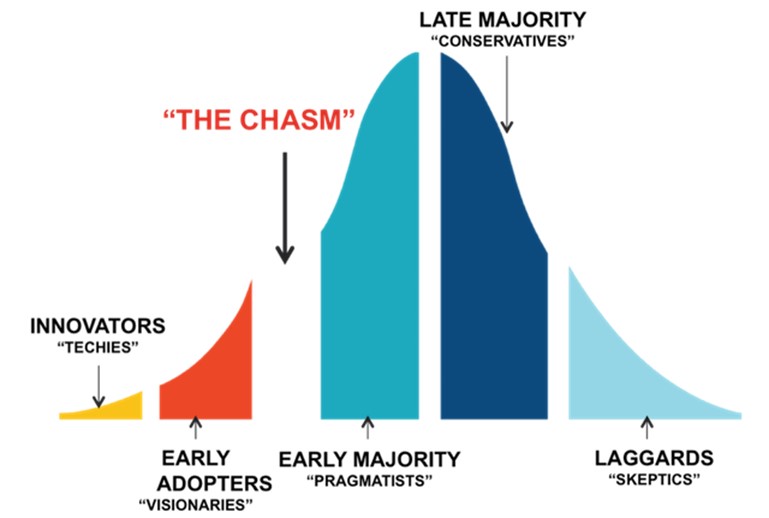By Anik Joshi, Senior Director, Business Intelligence, Hawthorne Advertising
It’s easy to use a top-down marketing strategy for product after product, but often it isn’t the most valuable approach for brands. When introducing new products, the framework of “crossing the chasm,” first introduced by Geoffrey A. Moore in his book of the same name, is a useful approach to keep top of mind. Crossing the chasm means executing a marketing plan that understands the consumer adoption curve – effectively taking a product from the early introduction phase through to mass market adoption.

Defining the Chasm
Identifying the chasm in the first place can be tricky. The space between the early and mainstream markets is the chasm where product sales can reach a plateau. This plateau is often where innovative products go to die – not because they are bad products, but because the marketing plan did not account for crossing the chasm. Originally applied to technological innovations, the idea of the chasm, and crossing it, can be applied to any product with the goal of shifting consumer behavior. The process has a slow start, but after crossing the chasm, growth is exponential. How to cross this chasm is the million-dollar question.
How to Cross the Chasm
The first step to crossing the chasm is recognizing that there are two markets with different buying behaviors: the early market and the mainstream market. Innovators comprise the early market, along with early adopters – these audiences are up-to-date on product launches within a given industry and are very savvy. The average consumer comprises the mainstream market, or someone who would see value in a product, but may need to be convinced it’s right for them with additional information from the brand.
Early-adopters want the fastest, most innovative products, and are willing to pay a higher premium to receive those benefits. These audiences respond best, usually, to a product-centered approach, emphasizing qualities and highly-technical differentiators.
On the other hand, for the mainstream consumer, a market-centered approach should communicate compatibility and situational value. The product should solve a relevant problem and shouldn’t be too complicated to use.
Crossing the Chasm IRL
One example of Hawthorne’s experience with crossing the chasm occurred while working with a consumer technology company whose main business is data storage devices. This company made disruptive changes to its product, transforming it from a hard drive to a cloud-like device. The product was designed with women as it its target demographic for early market launch. Most computing gear targets the male demographics, so the female focus created a unique opportunity for this technology company to initially leverage a demographic that was not over-saturated.
Hawthorne developed a marketing campaign to highlight the features of this product that set it apart from competitors within the same space. Hawthorne initially launched the product with a focus on women and product-centered messaging—garnering strong “early-adopter” sales. However, post-campaign analysis and a qualitative study revealed an unmet market need around data privacy that the product could address in a very unique, differentiated way. Hawthorne successfully shifted to a more market-centered strategy, emphasizing the data privacy benefit and adding media/creative targeting the male market, effectively crossing the chasm by moving the product from early market into the mainstream.
Strategies to Cross the Chasm
While there are several ways to cross the chasm, the basics involve understanding how the product has served the early market, and how it will serve the mainstream market. Qualities like pricing or branding or product functions/benefits may need to shift to create a more mainstream appeal. It’s unusual that there’s a large, unmet need in the mainstream market – more often than not, brands will need to differentiate themselves from competition through branding and marketing. Brands may need to identify a more niche target buyer than previously explored, or better communicate the product’s key differentiators.
For example, a product may not have technical features that competitor products have, but it could offer better privacy settings for users’ data – that’s a unique selling point that should be emphasized to a target audience of privacy-conscious mainstream market consumers.
Monitoring potential competitors is another key strategy for crossing the chasm. An awareness of trends in your market helps you develop a plan for your products.
Three Key Considerations When Crossing
How can you apply the right “crossing the chasm” strategy for your product? There are three considerations to keep in mind:
- A features vs. benefits comparison. In the case study above, Hawthorne shifted from the product- to market-centered approach by doing research, identifying an unmet need that we could more effectively position to attract a larger, mainstream audience versus early adopters
- A creative messaging evolution: The mainstream audience will have different expectations than early adopters; as a result, creative needs to evolve, and the Hawthorne team are experts in identifying and executing both subtle and more drastic evolutions.
- A communications plan assessment. Shifting from a product- to market-based centered approach will usually mean a shift in target audience which leads to a different media mix.
Developing an effective marketing strategy using these principles can push your product out of the early market and into the mainstream. If you find yourself facing the chasm, drop us a note and we can help.





